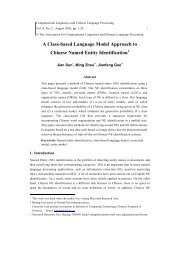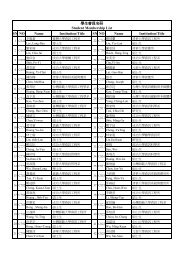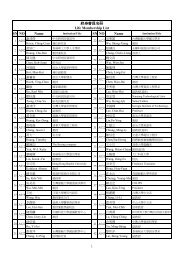Machine Translation Approaches and Survey for Indian ... - aclclp
Machine Translation Approaches and Survey for Indian ... - aclclp
Machine Translation Approaches and Survey for Indian ... - aclclp
Create successful ePaper yourself
Turn your PDF publications into a flip-book with our unique Google optimized e-Paper software.
<strong>Machine</strong> <strong>Translation</strong> <strong>Approaches</strong> <strong>and</strong> <strong>Survey</strong> <strong>for</strong> <strong>Indian</strong> Languages 592005). The strategy in this MT system is better than the transfer approach <strong>and</strong> lies below theInterlingua approach. In the first stage, a pattern directed parsing is per<strong>for</strong>med on the SLEnglish, which generates a `pseudo-target' that is applicable to a set of <strong>Indian</strong> languages. Wordsense ambiguity in the SL sentence also is resolved by a number of semantic tags. In order totrans<strong>for</strong>m the pseudo TL into the corresponding TL, the system uses a separate text generatormodule. After correcting all ill-<strong>for</strong>med target sentences, a post-editing package is used makethe final corrections. Even though it is a general purpose system, it has been applied mainly inthe domain of public health at present. The ANGLABHARTI system is currently implementedfrom English to Hindi translation called AnglaHindi which is web-enabled(http://anglahindi.iitk.ac.in) <strong>and</strong> has obtained good domain-specific results <strong>for</strong> healthcampaigns, successfully translating many pamphlets <strong>and</strong> medical booklets. At present, furtherresearch work is going on to extend this approach <strong>for</strong> English to Telugu/Tamil translation. Theproject is primarily based at IIT-Kanpur, in collaboration with ER&DCI, Noida, <strong>and</strong> has beenfunded by TDIL. Professor RMK Sinha, <strong>Indian</strong> Institute of Technology, Kanpur is leading thisMT project.4.2 ANGLABHARTI -II by <strong>Indian</strong> Institute of Technology, Kanpur (2004)The disadvantages of the previous system are solved by introducing the ANGLABHARTI - IIMT architecture system (Sinha et al., 2003). The different approach, a GeneralizedExample-Base (GEB) <strong>for</strong> hybridization in addition to a Raw Example-Base (REB), is used toimprove the per<strong>for</strong>mance of the translation. Compared to the previous approach, this systemfirst attempts a match in REB <strong>and</strong> GEB be<strong>for</strong>e invoking the rule-base at the time of actualusage. Automated pre-editing <strong>and</strong> paraphrasing steps are further improvements in theproposed new translation approach. The system is designed in a way that various submodulesare pipelined in order to achieve more accuracy <strong>and</strong> robustness.At present, the ANGLABHARTI technology has been transferred under theANGLABHARTI Mission into eight different sectors across the country (Sudip et al., 2005).The main intention of this bifurcation is to develop <strong>Machine</strong> Aided <strong>Translation</strong> (MAT)systems <strong>for</strong> English to twelve <strong>Indian</strong> regional languages. These include MT from English toMarathi & Konkani (IIT, Mumbai): English to Asamiya <strong>and</strong> Manipuri (IIT, Guwahati):English to Bangla (CDAC, Kolkata): English to Urdu, Sindhi & Kashmiri (CDAC-GISTgroup, Pune): English to Malyalam (CDAC, Thiruvananthpuram): English to Punjabi (ThaparInstitute of Engineering <strong>and</strong> Technology-TIET, Patiala) English to Sanskrit (Jawaharlal NehruUniversity - JNU, New Delhi): <strong>and</strong> English to Oriya (Utkal University, Bhuvaneshwar).









